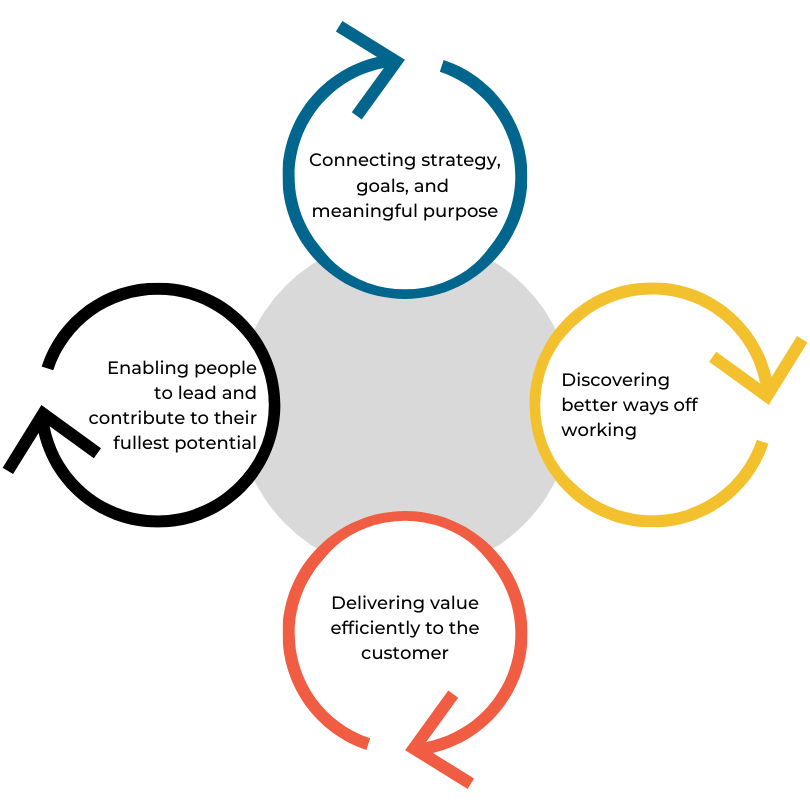There’s never been a time in our history where customers are more demanding, so how do businesses generate a sustainable competitive edge and raise the performance bar? A culmination of an agile and lean management may create the “perfect storm”, particularly during these recent times of uncertainty within a tough fiscal operating environment or many industry sectors.
Lean management creates value by deleting anything that doesn’t add value to the customer or end user, by encouraging employees to adopt a mindset of continuous improvement and flexible work processes.
Increased value does not always equate increased revenue. Which is where agility comes into the mix.
Agile models are more recent and according to the McKinsey report, call for iterative development that aims to get an early prototype of a new product or service out into customers’ hands as quickly as possible.
Working lean means eliminating waste. Being agile is to be adaptive, resilient, flexible and appropriate to the situation.
The lean management system is articulated through four integrated disciplines

You don’t need to choose – these two methodologies compliment not complicate business
Adopt a best-of-both approach
Using a combination of lean management and agile tools to improve
From the lean management toolkit, it used value-stream mapping and design thinking to completely rethink and restructure the customer experience for a given transaction or process. It also revamped key performance indicators to better reflect specific goals—for example, how fast a customer could get his or her issue resolved. From agile, the company created self-managing, cross-functional teams to improve collaboration and foster accountability. The new self-managing team enabled employees to handle all types of customer requests from end to end. Management also established a single point of contact for each process to reduce the number of internal handoffs and improve customer engagement.
Collectively, this approach led to a 90 percent reduction in the average time required to resolve a customer issue. Not surprisingly, customer satisfaction scores increased by 30 percent, as did employee engagement. The reorganisation means teams were no longer bogged down by bureaucracy and instead can see how their individual contributions have a direct result on the customer experience—and thus on the company’s overall performance.
So what about the future?
With the speed of change expected to continue, it’s never been more critical for an effective operating model, and take the time to Reflect, Decide, Commit, Embed and Scale for the next normal.

It is crucial to take the time to systematically reflect on lessons learnt, assess what practices worked and what didn’t during the pandemic, and decide which need to be embedded. This fundamentally leads to strategic decision making. For example, what differentiated amongst teams who coped well with work changes from the teams that struggled whilst identifying the gaps and actively engage in employee discussions regarding how to close those gaps.
Upon reflection, adjustments regarding operating model structural shifts need to be determined, which may incorporate simplifying decision making and experimenting with new behaviours and company practices, before scaling throughout the company.
Next steps are to commit to this transition because it is imperative for scaling an agile operating model and optimising the same objectives, is there’s buy-in throughout the company – take employees on the journey through clear and concise communications.
The transformational journey to an agile business with lean principles
Is it about company’s becoming faster, more productive and more responsive to deliver more sustainably? To become agile it’s also about mindsets, behaviours and adopting different working methods. For best results they should be interconnected.
Companies around the world are implementing the more efficient lightweight processes used by fast-responding, fast-moving and high-growth companies, now commonly known as Agile and Lean principles.
In addition to cross-functional teams you have groups of people singularly focussed on specific defined drivers or tasks. Being part of a team with a shared end goal can be empowering.
Combining both lean and agile methodologies provides more consistent value to your customers.
Actions to implement in your business today:
1. Take a look at what you’re doing today and what you can learn from other methodologies. Most teams have some core problems or opportunities for improvement enabling you to move to the next opportunity.
2. Explore notions of continuous improvement and methods to develop your team into a more cohesive unit will do wonders in creating added value within your business through a variety of measurable ways.
3. Lean focuses on making sure the requirements match user need and provide both company and customer value. An example relating to introducing software by executing the following tips:
- Encourage customer satisfaction by early and continuous delivery of valuable software/
- Welcome changing requirements, even in late development
- Deliver working software frequently (weeks rather than months)
- Prioritise close, daily cooperation between business people and developers
- Build projects around motivated individuals, who should be trusted
- Consider face-to-face conversation the best form of communication (co-location)
- Use working software as the primary measure of progress
- Assure sustainable development that allows you to maintain a constant pace
- Give continuous attention to technical excellence and good design
- Consider simplicity—the art of maximising the amount of work not done—essential
- Understand that the best architectures, requirements, and designs emerge from self-organising teams
- Reflect regularly with your team on how to become more effective and adjust accordingly.
In essence when it comes to agile and lean, the final result must ultimately create a value-add to the customer.
Operating a business typically presents complex issues to deal with, sometimes on a daily basis. Imagine if you could leverage the experience from an extensive group of industry peers to improve your decision-making and future-proof a sustainable business, whilst being held accountable?
Also imagine if you gained the peace of mind to seamlessly access these answers and navigate other business challenges, simply by connecting with entrepreneurs and business leaders? This is the strength of peer to peer and leadership mentoring.
Coraggio offers a mutual exchange of expertise, ideas and support system enabling you to capitalise on a give-and-take dynamic amongst advisors who have walked the path before mitigating risk to your business.
Coraggio Chairs are industry leaders, members are forward-thinking advisors and all Boards are dedicated to the ongoing success of their fellow member’s businesses, offering Fearless Objective Advice – that’s the Coraggion Spirit!
In the words of Henry Ford “If everyone is moving forward together, then success takes care of itself”.
Would you like to be a part of this?
Become an integral Member of a confidential group of business owners sharing their insights and experiences for the benefit of your business? Imagine how your business would prosper from connecting with a broader community consisting of more than 400 high performing and driven industry leaders!
Explore Membership today! Find out how our proven program can assist you build a better business and become a better leader.

